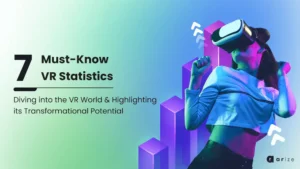AR continues to reach unprecedented popularity as it increasingly integrates into different fields and sectors. By 2023, AR and VR technology market is projected to have grown from $13 billion to over $14 billion.
As more and more use cases become commonplace, demand is expected to increase, especially in the face of emerging trends like the convergence between wearable devices and AR. It is estimated that over 1.4 billion people will be using AR on their mobile devices by 2023.
As AR continues to emerge, new trends develop. Let’s take a look at some of the trends to watch out for in 2023:
The Metaverse
Every business wants to leverage the metaverse to engage audiences, from e-commerce to fashion houses, music labels, and more.
This AR trend revolutionizes how users interact with each other and products from different industries, giving the most immersive customer experiences consumers have ever experienced online.
Business Mobile Apps
Augmented reality for mobile is a trend growing in leaps and bounds. Mobile AR will help businesses reach a broader customer base through experiences designed specifically for smartphones.
While AR on mobile is mainly used for entertainment with gaming apps like Pokémon GO and filters for apps like Snapchat and Instagram, brands will use it to create customizable, more personal experiences.
AR for Marketing
2023 will be the year that marketers begin to pay serious attention to augmented reality and its opportunities.
AR-based marketing materials can improve engagement and increase the likelihood of converting browsing into a purchase. More than 60% of shoppers prefer augmented reality, and more shop owners are moving towards AR solutions.
Live Stream Shopping
This trend, already popular in China (projected to grow into a 770 billion dollar market by next year), is hurrying toward other parts of the world. Brands are moving to use platforms like TikTok Live and Instagram Live to promote and sell products. It’s a new-gen version of the shopping channel. But with the added element of real-time interaction with the sellers and other shoppers.
This offers a lot of advantages, including accelerating the selling process.
AR Boosted by AI
Augmented reality and artificial intelligence work well together. Understanding data from the environment around you (as AR does) requires using complex algorithms, and AI can simplify this process and make it more accurate.
AR and AI can link together to create novel solutions. As AR technology progresses, AI’s use within it will also increase.
Wearable NFTs
Bringing digital collectibles to real life has become an emerging trend, and AR NFT allows consumers to not only wear fashion but also interact with it in the real world. Some of the world’s biggest fashion companies are very eager to use it to market their businesses. Burberry created a branded wearable NFT for Mythical Games’ Blankos Block Party title, while Dolce & Gabbana released “Collezione Genesi,” an AR wearable NFT collection that netted them nearly $6 million.
This is a progression from having avatars wearing your NFT collectibles in-game, and more and more brands will invest in it over the coming months.
The Bottom Line
AR is far from perfect, but it is moving phenomenally, with innovations happening seemingly daily. As more and more brands turn towards AR to augment their business, it is essential to keep up and proceed with the times.
Augmented reality trends will influence tech trends over the next year and beyond. Don’t get left behind.



